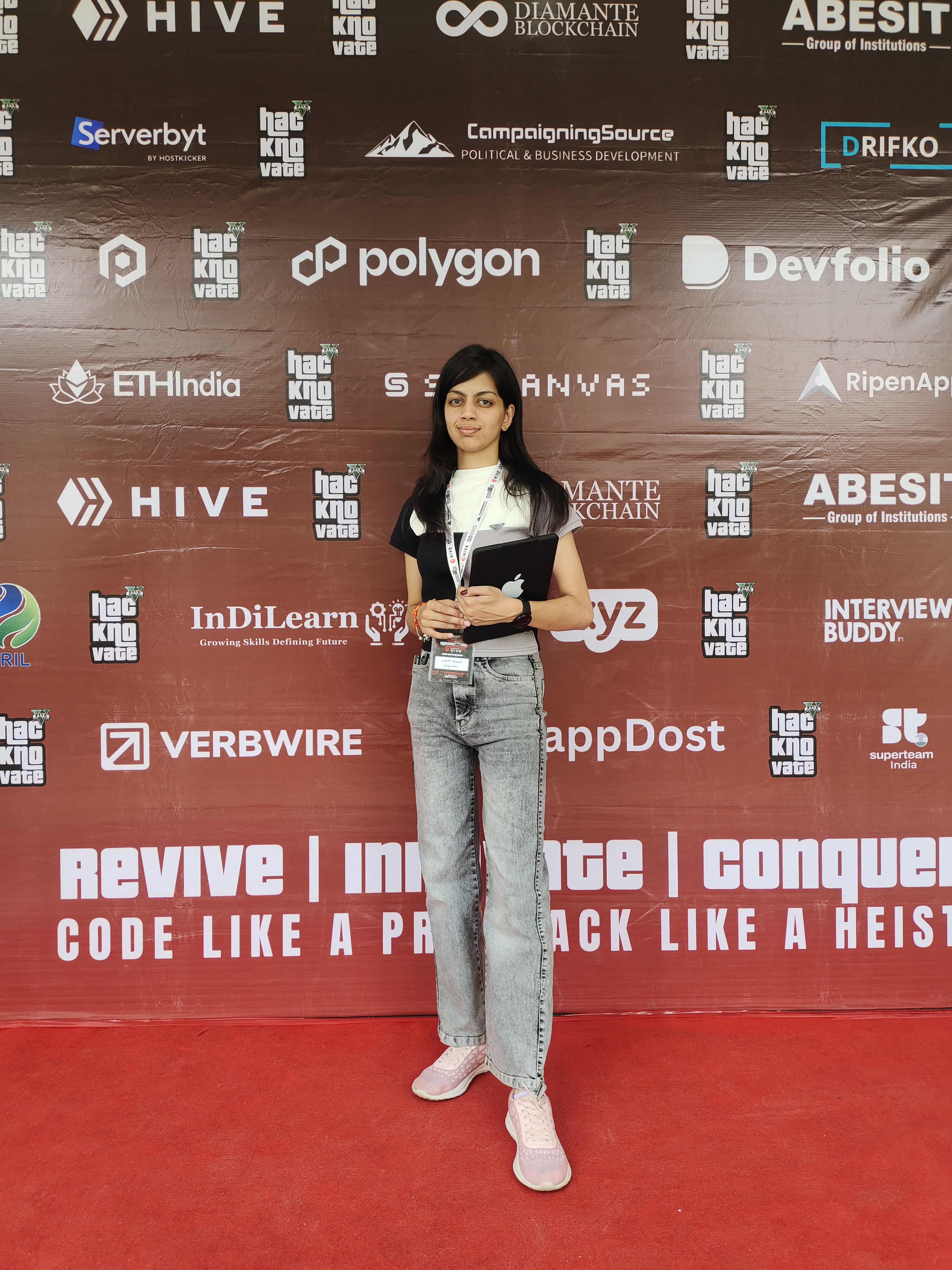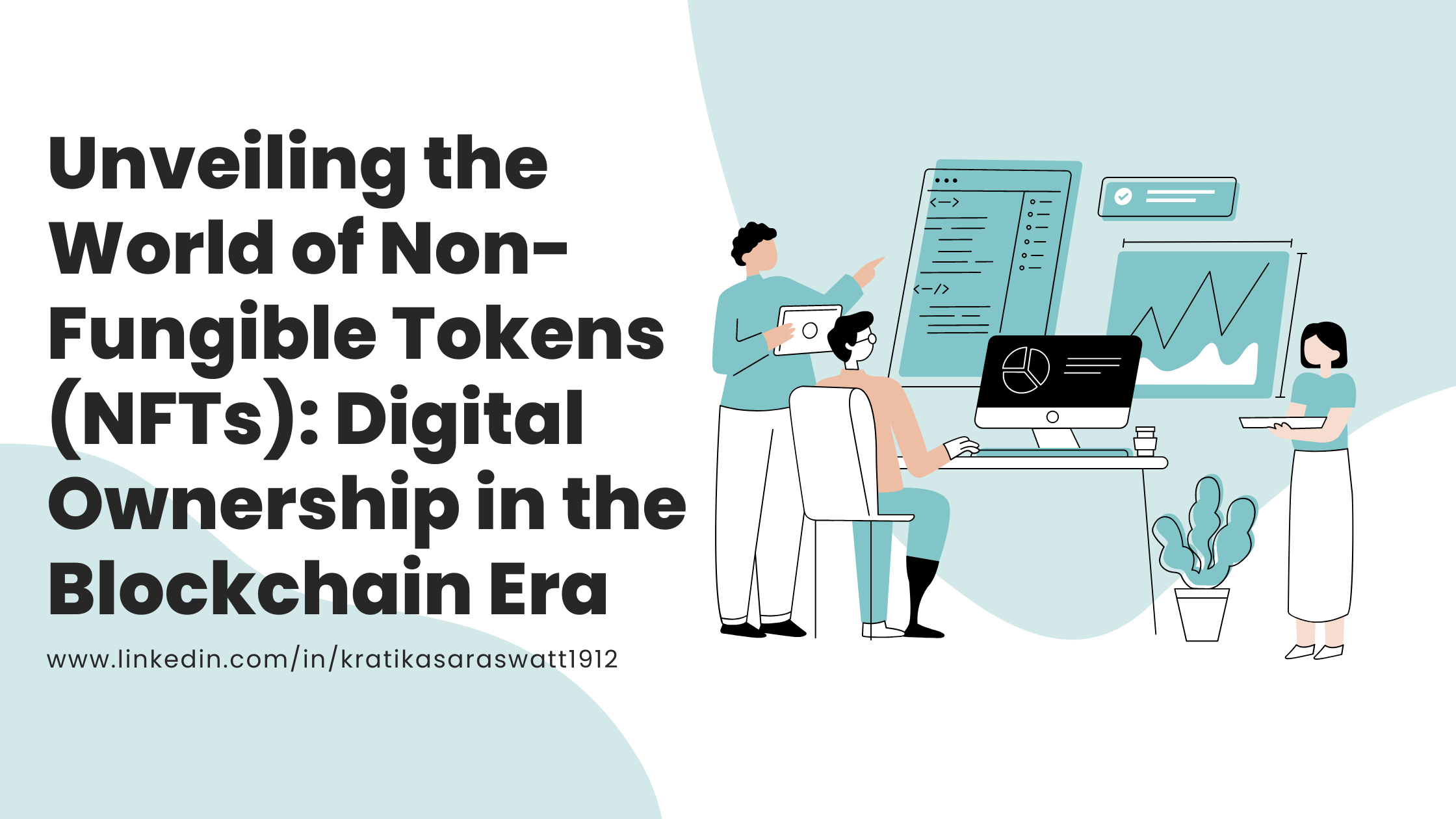Unveiling the World of Non-Fungible Tokens (NFTs): Digital Ownership in the Blockchain Era
 Kratika Saraswat
Kratika Saraswat
In the ever-evolving landscape of blockchain technology, Non-Fungible Tokens (NFTs) have emerged as a revolutionary force, transforming the way we perceive and trade digital assets. NFTs are unique cryptographic tokens that represent ownership or proof of authenticity of a specific item or piece of content on the blockchain. From digital art to virtual real estate, NFTs have opened up new possibilities for creators and collectors alike, creating a paradigm shift in the digital economy.
Understanding NFTs:
Uniqueness and Indivisibility: Unlike cryptocurrencies such as Bitcoin or Ethereum, which are fungible and interchangeable, each NFT is distinct and cannot be replicated. This uniqueness is achieved through cryptographic principles, ensuring the scarcity and indivisibility of the digital asset.
Blockchain Technology: NFTs rely on blockchain technology, often utilizing platforms like Ethereum, Binance Smart Chain, or others. The decentralized nature of the blockchain provides a transparent and secure ledger of ownership, eliminating the need for intermediaries.
Smart Contracts: Smart contracts play a crucial role in the functionality of NFTs. These self-executing contracts automate the process of transferring ownership, ensuring that the terms and conditions encoded within the contract are met before a transaction is finalized.
The Rise of NFTs in the Art World:
Digital Art and NFT Marketplaces: NFTs have democratized the art world by allowing digital artists to tokenize and sell their work directly to collectors. Platforms like OpenSea, Rarible, and Mintable have become popular marketplaces where creators can showcase and monetize their digital creations.
Tokenizing Real-world Assets: Beyond digital art, NFTs are extending their reach to the physical world. Real estate, music rights, and even virtual goods in video games are being tokenized, providing a novel way to represent ownership and transfer assets.
Challenges and Controversies:
Environmental Concerns: The energy consumption associated with certain blockchain networks, notably Ethereum, has sparked debates regarding the environmental impact of NFTs. Efforts are underway to address these concerns, with some projects exploring more eco-friendly alternatives.
Copyright and Plagiarism: NFTs have raised questions about copyright and intellectual property rights, particularly in cases where digital content is tokenized without the creator’s consent. The industry is evolving to establish clear guidelines and mechanisms to address these issues.
Future Outlook:
Integration with Virtual Reality (VR) and Augmented Reality (AR):
The convergence of NFTs with VR and AR technologies is anticipated to create immersive digital experiences. Virtual spaces where NFTs can be displayed and interacted with may become the next frontier in the evolution of digital ownership.
Broader Adoption Beyond Art:
NFTs are expected to find applications in various industries, including gaming, education, and healthcare. The ability to represent ownership and authenticity in the digital realm opens up possibilities for diverse use cases.
Let’s delve deeper into certain aspects of Non-Fungible Tokens (NFTs):
NFTS IN THE GAMING INDUSTRY:
Virtual Assets and In-Game Items: NFTs are gaining traction in the gaming world, enabling players to truly own and trade in-game assets. Whether it’s rare weapons, character skins, or virtual real estate, NFTs provide a secure and transparent way for gamers to buy, sell, and trade their digital possessions.
Play-to-Earn Models: NFTs are at the forefront of the play-to-earn revolution, where gamers can earn real-world value by participating in and contributing to virtual economies. This has the potential to reshape the gaming industry’s economic landscape, rewarding players for their time and skill.
NFTS AND THE MUSIC INDUSTRY:
Tokenizing Music Rights: Musicians can tokenize their work, allowing fans to buy and own a share of the rights to a song. This not only provides a new revenue stream for artists but also strengthens the connection between creators and their audience.
Royalties and Smart Contracts: NFTs enable transparent royalty distribution through smart contracts. Musicians can set conditions for automatic royalty payments every time their music is sold or used, reducing intermediaries and ensuring a fair compensation structure.
NFTS IN EDUCATION:
Certifications and Degrees: Educational institutions can use NFTs to issue digital certificates and degrees, providing a tamper-proof and verifiable record of academic achievements. This can streamline the hiring process for employers and reduce the risk of credential fraud.
Tokenized Learning Resources: NFTs can represent ownership of digital learning resources, allowing educators and content creators to monetize their work. This decentralized approach to educational content distribution could empower educators and learners alike.
CHALLENGES AND INNOVATIONS:
Scalability and Gas Fees: High gas fees and scalability issues on certain blockchain networks, particularly Ethereum, have been challenges for NFT adoption. Layer 2 solutions and alternative blockchains are being explored to address these concerns and enhance the overall user experience.
Interoperability: Achieving interoperability between different blockchain networks and NFT standards is crucial for the seamless transfer of assets across platforms. Efforts are being made to create standards that facilitate cross-chain compatibility.
SOCIAL IMPACT OF NFTS:
Empowering Underrepresented Creators: NFTs provide an opportunity for underrepresented artists and creators to gain visibility and monetize their work without traditional gatekeepers. This democratization of the creative space has the potential to foster diversity and inclusivity.
Philanthropy and Charitable NFTs: Some NFT projects are dedicated to charitable causes, with a portion of the proceeds from NFT sales going to philanthropic initiatives. This aligns with the idea of using blockchain technology for social good.
THE ROLE OF DECENTRALIZED AUTONOMOUS ORGANIZATIONS (DAOS):
Community Governance: DAOs, enabled by blockchain and NFTs, allow communities to govern and make collective decisions. This can include decisions about the development of a project, allocation of funds, and overall governance, providing a more democratic approach.
Community-Owned Assets: NFTs can represent ownership in decentralized autonomous organizations, giving community members a stake in the success and decision-making processes of a project.
Non-Fungible Tokens have undoubtedly disrupted traditional notions of ownership and value in the digital age. As the technology continues to mature and address challenges, NFTs are poised to reshape industries, empower creators, and redefine the way we perceive and trade digital assets. The journey has just begun, and the future promises an exciting exploration of the limitless potential of NFTs in the blockchain era.
As the NFT space continues to evolve, it will be fascinating to witness how these innovations reshape industries and create new possibilities in the digital realm. The intersection of blockchain, NFTs, and various sectors holds the promise of a more decentralized, transparent, and inclusive future.
Subscribe to my newsletter
Read articles from Kratika Saraswat directly inside your inbox. Subscribe to the newsletter, and don't miss out.
Written by
